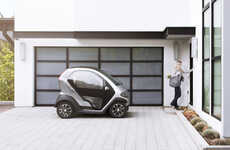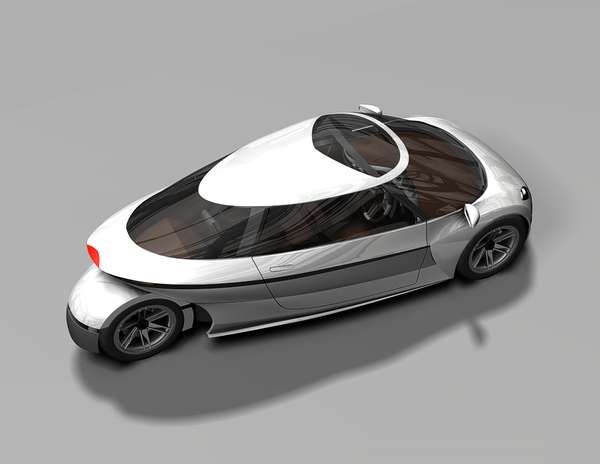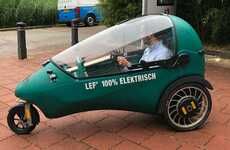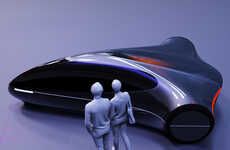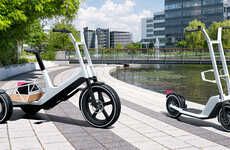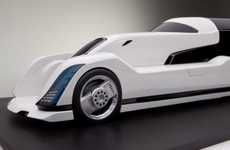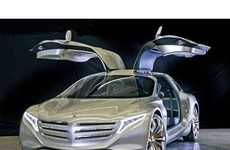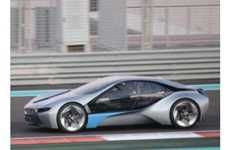
Space Efficient Vehicles
Ralph Panhuyzen — May 6, 2008 — Autos
References: michelinchallengedesign
When it comes to damaging the environment, vehicle length is not the issue. Width is. Streamlined, lightweight vehicles like the so-called Space Efficient Vehicle (SEV) that you see presented here, will dramatically reduce fuel consumption and emission levels.
Most governments expect a further increase of personal mobility. Cars seem bigger each year, and 'big' has a tendency to ruin a car's fuel economy. Rising fuel demand causes fuel prices to rise even more. The growing number of cars showing signs of becoming seriously obese, tend to clog up 'arteries,' or the infrastructure.
Building new roads is expensive, sometimes even impossible because of the limited amount of space. Most governments have committed to reducing CO2 and the use of fossil fuels. Many are planning to introduce some sort of road pricing. Demographics are constantly changing. Particularly in densely populated urban areas the average household becomes smaller. 90-95% of the people normally drive alone anyway, particularly when commuting or running errands.
So, why don't we slim down our mode of transport? Here lies a great opportunity for governments and tax payers/car drivers to save billions and for the industry to make billions.
Governments will be able to utilize present freeways and parking facilities far more efficiently. 'Lightweight' allows for lean, sustainable manufacturing, and may contribute to substantially raising a manufacturer's profit margins and improve his overall mpg and emission profile.
The SEV concept that many car enthusiasts perceive as a next-generation (BMW) Isetta, Heinkel or Messerschmitt , is catering to a whole new market that has not been catered yet. The SEV combines striking good looks, substantial savings, an eco-friendly lifestyle and personal mobility. What about 70-105 mpg with a small conventional gasoline engine? All electric would be possible too. It is easy to see why the three-seat SEV would be more practical, safer and more comfortable than the Smart ForTwo. Probably cheaper to manufacture as well.
Most governments expect a further increase of personal mobility. Cars seem bigger each year, and 'big' has a tendency to ruin a car's fuel economy. Rising fuel demand causes fuel prices to rise even more. The growing number of cars showing signs of becoming seriously obese, tend to clog up 'arteries,' or the infrastructure.
Building new roads is expensive, sometimes even impossible because of the limited amount of space. Most governments have committed to reducing CO2 and the use of fossil fuels. Many are planning to introduce some sort of road pricing. Demographics are constantly changing. Particularly in densely populated urban areas the average household becomes smaller. 90-95% of the people normally drive alone anyway, particularly when commuting or running errands.
So, why don't we slim down our mode of transport? Here lies a great opportunity for governments and tax payers/car drivers to save billions and for the industry to make billions.
Governments will be able to utilize present freeways and parking facilities far more efficiently. 'Lightweight' allows for lean, sustainable manufacturing, and may contribute to substantially raising a manufacturer's profit margins and improve his overall mpg and emission profile.
The SEV concept that many car enthusiasts perceive as a next-generation (BMW) Isetta, Heinkel or Messerschmitt , is catering to a whole new market that has not been catered yet. The SEV combines striking good looks, substantial savings, an eco-friendly lifestyle and personal mobility. What about 70-105 mpg with a small conventional gasoline engine? All electric would be possible too. It is easy to see why the three-seat SEV would be more practical, safer and more comfortable than the Smart ForTwo. Probably cheaper to manufacture as well.
Trend Themes
1. Lightweight Vehicles - Opportunity for manufacturers to create streamlined, fuel-efficient cars that reduce fuel consumption and emissions.
2. Space Efficiency - Opportunity to develop vehicles that maximize space and improve traffic flow in urban areas.
3. Sustainable Manufacturing - Opportunity for manufacturers to adopt lean and eco-friendly manufacturing processes that increase profit margins and improve fuel efficiency.
Industry Implications
1. Automotive - The automotive industry can explore the production of lightweight vehicles that offer better fuel efficiency and space efficiency.
2. Transportation - The transportation industry can benefit from the development of space-efficient vehicles that improve traffic flow and reduce congestion in urban areas.
3. Manufacturing - Manufacturing companies can adopt sustainable practices to create lightweight vehicles that have lower environmental impact and higher profit margins.
3.7
Score
Popularity
Activity
Freshness




